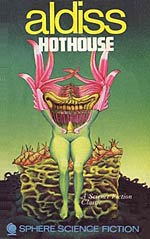
![]() llLeoll
llLeoll
3/11/2013
![]()
Hothouse by Brian Aldiss is an odd book. An unnamed disaster has destroyed human civilization, leaving in its place pygmy humans who live like animals in a dangerous, very violent jungle populated almost exclusively by vegetable matter. And the jungle has taken over at least half of the world because the earth now, like the moon, has one side continually facing the sun, which gets hot.
This is not, however, our ancestor's jungle. Instead of peaceful, these jungle plants have teeth. Literally. In Aldiss' world, aggressive plants, nightmare descendants of the Venus fly trap, are the main predators.
The story revolves around the travels of Grem, a man-child, through this "Dying Earth" style world. He meets giant termites -- indeed, the termites are the size of the pygmy humans -- who engineer large castles. And sentient fungi, the Morel, who have the ability to control the minds of the beings it attaches to. And huge, mile-long spider-like plants, called the "traversers," who travel their webs between earth and the moon. The oddest creature he meets, though, is the wise Sodal Ye, a dolphin who is born on the back of three humans.
Overall, this book feels more like Fantasy than Science Fiction. That often works for me when, like Lord of Light, the science is plausible, and the story arises from the conditions naturally. Unfortunately, the science in Hothouse seems forced. And the explanations tenuous. For instance, Aldiss postulates a moon that hangs in one fixed location above the earth. Which, given the laws of gravity, would never work. The moon, without its orbit around the earth, would crash to the earth. The reason is simple: the moons orbit is a balance between the moon's trying to catapult past the earth and its attraction to earth's gravitational field.
There are other scientific implausibilities. Like the traversers climbing their webs to the moon. And adopting the same body plan as current spiders. And what of the termites at over a foot high. To attain that height, their internal structures would need to change drastically as the increased volume of their innards would soon cause the build-up of toxins (since their surface area would increase as a square of the increased size, versus the cube for the volume). And their chitin exoskeletons would soon become to weak or too heavy to support them due to the area/ volume relationship.
That said, it is a decent tale. I really wanted to give it 3.5 stars. But it really was not good enough for me to give it 4 stars.
Leo Walsh is a writer. His first novel, a work of science fiction titled "even snow melts" will be available on Amazon in March or April 2013 For more thoughts from Leo, check out his blog at leo-walsh.com.